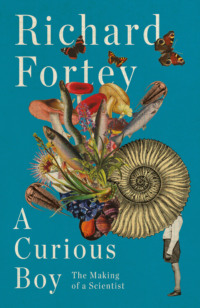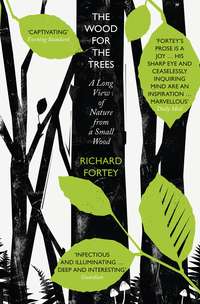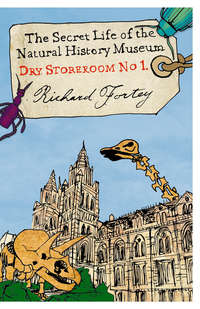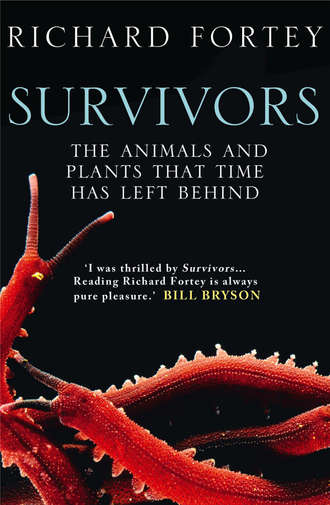
Полная версия
Survivors: The Animals and Plants that Time has Left Behind
My visit to Mistaken Point convinced me that it was possible for whole groups of organisms to disappear from the biosphere. There are some scientists who claim that the organisms preserved there – they have been called Vendobionta, among other things – are a kingdom (like Animalia) that has become extinct; a kingdom of ‘quilted’ animals that many of the same scientists also think may have harboured bacteria in their body compartments in some kind of symbiosis. The somewhat younger fossils from the Ediacara Hills in Australia also include a variety of ‘quilted’ organisms, but some of these seem to show a clear front end – a head. One of these, a creature called Spriggina, has been quoted as a kind of soft-bodied trilobite precursor. The more I look at Spriggina, the more I doubt it. The numerous ‘segments’ seem to be out of step on either side of the animal, and the head end looks like a boomerang and not really like the forerunner of a head-shield. In fact, when you examine it impartially it looks more like another apparently quilted and very un-trilobitic animal called Dickinsonia. But there is no question Spriggina is an intriguing animal, and I would love to be proved wrong. An Australian school of palaeontologists identifies soft-bodied ancestors of a few, living types of animals among a group of strange Ediacarans that are not quilted. An odd, radially symmetrical creature called Arkarua is claimed as an ancestral echinoderm, for example; a thing that looks something like a snowshoe called Kimberella has been claimed as a mollusc. Every one of these animals courts controversy. But at least some of these Australian Ediacaran animals, including Kimberella, are symmetrical about a line running along their midriff. This may not seem much, but it does show that below the Cambrian there were animals that could be placed in Bilateria – that is, animals with left and right sides that are mirror images (or bilaterally symmetrical). The common ancestor of arthropods, molluscs, annelid worms, and flatworms, not to mention the ancient relatives of velvet worms, would have been bilaterally symmetrical. We shall return to the interesting questions of the early days of animal evolution.
Vendobionts (or call them what you will) seem to have colonised all the seas of the world before the Cambrian Period. They were the first large organisms, and the younger and more advanced ones were certainly animals. Explaining exactly what they were has taxed the ingenuity of many clever people; but they have in all likelihood vanished from the world (the organisms, I mean, rather than the clever people). Some of the quilted animals that lived in shallow water may, possibly, have housed symbiotic algae or bacteria in their tissues, and basked in the sunshine, like prostrate reef corals. On the other hand, the Mistaken Point fauna appear to have lived in too deep and too turbid an environment for this to be a plausible option. It is perhaps not surprising that such strange creatures have inspired strange explanations. One worker even claimed that the vendobionts were not animals at all, but lichens, the living symbiotic collaboration between fungus and ‘alga’* that coats trees and rocks almost everywhere in the world. Lichens are the ultimate biological survivors in the simplest sense, because they seem to relish hardship and the tough life. However, none of them is adapted to life in the sea. The fact that some lichens have a flat and foliate form, as do the Precambrian ‘spindles’, indicates no more than a broadly similar way of growing over flat surfaces. Life’s history is as full of repetition as it is of endless inventiveness.
The waves surge and retreat from the stacked-up sea floors that once built Mistaken Point. This continually punished land will inevitably succumb to erosion, and the record of ancient life buried by chance so long ago beneath clouds of volcanic ash will be returned to the sea as a billion tiny particles. In the end, only the sea endures, it is the greatest survivor of them all. Even the continents mutate and remake themselves, driven by the internal engines of the earth powering slow but inexorable movements of tectonic plates. Mountain ranges are elevated and then reduced to rubble, but life can outlast mere Himalayas. Peripatus’ relatives once walked upon Gondwana when Africa was united with Australia and the Americas. The memory of
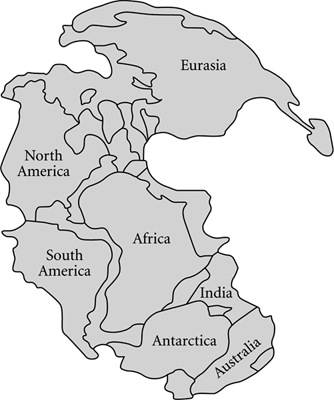
5. Pangaea – where the continents of the world were united as one ‘supercontinent’ 270 million years ago. The southern mass (South America, Africa, India, Antarctica, Australia) is Gondwana.
that vanished geography still lingers under rotting logs, or whispers through the leafy boughs of podocarp forests. Briefly, at least geologically speaking, all the continents were united together in the supercontinent called Pangaea (Greek: ‘all earth’) some 270 million years ago. But that mighty entity, too, was just a phase, just one configuration of the earth’s ever-changing physiognomy. For earlier still there was a time when continents were dispersed once more, making for a geography that looks still odder to our eyes. Science tries to reconstruct this former world map: it is like cutting a jigsaw puzzle into a set of new pieces, and then attempting to refit them into another picture altogether. By the Cambrian Period some 500 million years ago, these scattered continents were naked with their rocks unclothed by plants. The distant relatives of the velvet worm were there, though, living beneath the sea among a host of other creatures: some strange, some familiar. The lobopods were more diverse then than they have ever been since.* The branches of the tree of life were drawing closer to a relatively few common major limbs, but there was still a great variety of crawling, swimming, floating, burrowing creatures. There were livings to be earned: prey to hunt, hideaways to construct, plankton to be filtered, mates to be found. But then we must go back further, still further, into the Ediacaran. The surf at Mistaken Point washes over an even earlier, but alien world, a vanished world of soft-bodied, fractal things. There may have been no predation then, no burrowing, no grazing, no evidence of ‘nature red in tooth and claw’. It was a different biosphere, and its mysteries still elude us. And the fossils of Mistaken Point prove that not everything survived.
The search for the velvet worm leads to unsuspected places and puzzling worlds.
3

Slimy Mounds

Shark Bay is a long way from anywhere. In Australia, distance soon acquires its own curious rules. Within the suburban strip that lines favoured parts of the coast there are traffic jams and shopping malls like anywhere else, but away from civilisation the outback country stretches onwards forever. Far from the mountainous east, much of the country is flat. No doubt connoisseurs of the horizontal find infinite entertainment in its small variations, but for me a bemused puzzlement sets in after a few hours apparently rehearsing the same piece of landscape numerous times. Time begins to stretch in odd ways. After a snooze, I wake up unsure whether I have been asleep for ten minutes or two hours. Small eucalypts line wandering creeks while sand dunes are covered with scrub, occasional scruffy fences mark obscure ownership, and there are groves of taller gums or isolated she-oaks stocked with the noisy parrots known as galahs. Then the sequence repeats, but not necessarily in the same order. The landscape is utterly distinctive, like that of nowhere else in the world, with a stark beauty under a clear pale blue sky, but it is also relentlessly repetitive. Anyone foolish enough to leave the marked track will find it is easy to get lost. Bush stories are full of sticky ends and grieving widows. I know that maps do not really work in a landscape that repeats like an old tune whistled over and over.
Route 1, running up the west coast of Western Australia towards Shark Bay, seems never to end. The Greyhound bus runs onwards through the dark, with nothing really distinguishing the passage of miles except sporadically a startled kangaroo picked out in the headlights. Occasional vehicles pass the other way, and each one seems something of a surprise. What can they be doing out here? I have to remind myself yet again that I am en route to see one of the holy relics in geology; it will be worth the effort. After countless hours, the Overlander Roadhouse welcomes me – a neon-lit marker set down in the endless landscape; a gas station, with a rudimentary restaurant, a place to loaf about until the next bus arrives. Aboriginal people wait there desultorily for relatives who have been off to Perth or somewhere to make a few dollars. Flies buzz about, with irritating persistence; there must be something else for them to do than endlessly return to drink from the same sweaty brow, or so one would think, but round and round they go. Backpackers loiter, waiting to embark on the next section of an adventure planned in theory, but now measured out in sweat and flies. It is a kind of end-of-the-world place, on nobody’s list of ‘must-sees’, but an essential stopping point before negotiating the wilderness. This is a place where timetables mean something to somebody, a place where I can get the next bus to see the stromatolites. Not far from the Overlander Roadhouse is a place that tells us of the transformation of the very air we breathe, a window opening into remote Precambrian times.
Though the outback may look pristine, in this part of Australia the wildlife has been transformed by human introductions. Feral goats have degraded the natural bush, and cats have culled the nocturnal mammals that were once numerous. The big-eared marsupial bilby, with its back legs like a miniature kangaroo and improbably long tail, is such a charming animal that it has become a kind of mascot for the conservation movement hereabouts. It would indeed be tragic if its only permanent memorial were in one of those perfectly photographed wildlife television programmes. Conservationists in Australia have taken to referring to the ‘Easter bilby’ rather than the ‘Easter bunny’ (bunnies being voracious introductions, too). It is already too late for many small marsupials in the eastern states of the country; their only record now being watercolour drawings made by the early naturalists. These harmless creatures could not outwit intelligent feline and canine hunters, and they failed to survive. Australia is full of poignant paradoxes. This land has many ancient biological survivors yet it is also, much like New Zealand, a place where the extinction of species is still in progress. This is despite the efforts of a generation of Australians many of whom treasure their unique fauna and flora. Almost every town boasts dedicated people concerned with ‘bush regeneration’, and in Western Australia new species of beautiful indigenous plants are still being discovered regularly, even around Perth. It is a very biodiverse region, despite the challenges of the climate, and not yet fully known. While I was there Tropical Cyclone Hubert turned the sky black, and sections of the main road were closed. The species that live in this tough land must be natural survivors to be able to negotiate fluctuations between flood and swelter. That description, of course, also includes feral cats.
Shark Bay is a huge and ragged bite into the profile of the west coast of Australia. It has now become a World Heritage Area, which brings more money and more tourism. Much of the former, and nearly all of the latter, is directed to the beach resort of Monkey Mia where ‘swimming with dolphins’ is on offer. When I flew over the Bay and its clear waters in a light plane, I saw an undulating submarine prairie of sea grass, dark emerald green, broken into banks like meadows. A tenth of the world’s dugongs – 250 kilograms of peaceable herbivorous sea mammal – graze in leisurely fashion upon this luscious expanse, many living to seventy years or more. Juicy fishes doubtless account for the name of the Bay, since they attract fourteen species of sharks, including species like the tiger shark that command respect. From the air I saw how Shark Bay is divided into two large lobes by a median peninsula; the aboriginal name for the Bay is ‘cartharrgudu’ (‘two bays’). The top of the peninsula is now the Francois Peron National Park and a serious attempt is being made to clear this sandy area of feral goats and predators for the benefit of the native fauna and flora. Dirk Hartog Island provides an outer barrier to the Bay, which protects the coast from storms cutting across the Indian Ocean. I never knew before visiting Western Australia that this island was the first landfall for any European. The Dutchman, Dirk Hartog, landed here on 25 October 1616, beating Captain Cook to it by 152 years, and leaving a pewter plate nailed to a post as evidence. That plate is still preserved in the Rijksmuseum, Amsterdam. William Dampier, ‘the buccaneer explorer’, spent a week there in 1699 and gave the Bay the name we use today. The aboriginal fishermen were plying their trade at the time, but there is little evidence of them now. I conclude that it is not only small and shy marsupials that failed to survive.
My quest is for something altogether more recherché than shark or dugong. At the tip of the eastern bay the edge of the sea provides a prospect of life two billion years ago … I am travelling incredibly far back in time. The journey to the old telegraph station at Hamelin Pool takes me through undulating, intensely green scrub interspersed with a few mallee trees, interrupted only occasionally by flat-bottomed depressions carrying scrappy salt-scrub and patches of white gypsum – the aboriginal inhabitants called these clay-pans birridas. I missed the flowering season, and now all the bushes seem to bear black nuts. Next come low dunes made up of startlingly white tiny shells. I crunch my way across the dunes, and beyond lies a very shallow arm of the sea. This is where the stromatolites grow. I am approaching the famous site where living analogues still flourish of the most ancient organic structures on earth. They ought to have disappeared long before the first velvet worm or horseshoe crab, but here they linger on, a marvel of anachronism.
Back at the highway must be the only road-sign in the world that points to ‘STROMATOLITES’, and no geologist or palaeontologist could fail to follow its bidding. Here they are growing by the shore while the sea beyond shines an almost improbable ultramarine. Is this luminous vision the time warp I sought? Some part of me expects the stromatolites to be green, but they prove to be darkish umber brown. I confess I am momentarily disappointed. They comprise flat-topped cushions and low pillars, or even giant mushrooms expanding upwards like plush stools, with sandy gullies between them. They are regularly disposed along a seaboard more than a hundred yards wide; seawards they disappear beneath the barely lapping waters. It is a scene of perfect calm. A little walkway has been built over the strand so that visitors can get close without damaging the organic structures. I touch one of the hummocks. It is actually quite hard (why did I expect it to be soft?) and slimy or tacky to the touch when moist, but almost crispy when dry. In the bright Australian sun it is even a little warm. Now that I get closer I can see other kinds of surfaces along the shore, particularly sloping stretches of dimpled microbial mats, a fruity brown colour, running down to the glittering sea. They make stretches of the shoreline resemble wrinkled skin. Stromatolites growing at the water’s edge look less like cushions and more like knobbly cauliflower heads. The inevitable flies are buzzing about my head, and some antipodean swallows chirrup cheerfully about the platform. I hope they are after my flies.
Up on the shore are some dead stromatolites, left behind by the sea maybe a thousand years ago. By now they have decayed into iron-stained ruins, but where they have broken open they show the internal structure of the cushion-shaped columns. It is clear to me that the columns are layered internally parallel to their top surfaces, rather like filo pastry. They seem to be built up layer by layer – a little like those giant stack pancakes an unwary visitor gets offered in New York for breakfast. The columns were evidently living things, self-made towers. A little museum on the site of the old telegraph office nearby provides more explanation. I peer closely at a stromatolite kept in a glass tank; its enveloping seawater must be refreshed every month. I see that when water covers the column its surface is slightly fuzzy – no doubt, it is still alive. A lack of crisp definition is somehow a proof of metabolism in action, life blurring the edges. Little bubbles fizz upwards off the top in a steady stream, none bigger than a lentil: they are bubbles of oxygen. So the column is evidently more than a brownish crust, it is something altogether more potent and dynamic, and it is breathing out oxygen, the element that babies and bilbies and bunnies all need to stay alive. Everyone has had nightmares about suffocation, when fighting for breath becomes fighting for life, so we all know in our bones how quickly we would perish without oxygen. The exhibition reminds me of the demonstration of nature in action at my very first school, when us kids looked at water-weed in a full glass beaker, and saw the same little bubbles of oxygen rising to the surface. This was the first time I heard the word ‘photosynthesis’.
The survival of the stromatolites on the beach is another measure of their toughness. On the foreshore I see two broad grooves carving their way through the stromatolite grove. These are the persistent traces of a former industry. In the late nineteenth and early twentieth century, camel trains brought bales of wool here to Flagpole Landing. These were then carted off the foreshore to lighters that sailed 190 kilometres to a boat waiting in deep anchorage off Dirk Hartog Island. Then the wool was transported to Fremantle and finally to the United Kingdom for manufacturing. We are fortunate that these activities did not destroy the mounds completely. But it is also a measure of the slow rate of biological activity hereabouts that the old tracks are still visible after a century.
Sea conditions in this part of Shark Bay are quite particular. The shallow seawater evaporates fast under the relentless sun. It is the basis of a salt industry at Useless Loop nearby. The very clear water has an elevated salinity and is very poor in nutrients. Hamelin Pool is backed up behind a sand bar known as Fauré Island, lying about forty-seven kilometres out to sea, so it is almost a lagoon. Only specially adapted or tolerant organisms can survive under these conditions. One of those animals is a little clam called Fragum hamelini, which, as the name implies, is special to this locality. It is so abundant that its snow-white shells, none bigger than a walnut, make up the dunes that line the Bay. After some decades the shells harden into a shelly rock – it would be an exaggeration to call it a limestone. An old quarry above the shore records the employment into which this curious white stone has been pressed. Cut into blocks the size of large bricks it made a serviceable, if hardly robust building stone. Some of the older edifices made of it still stand. The stone was used to build the walls of the Pearler Inn in the town of Denham, eighty kilometres distant. This pub looks as if it were constructed from a mass of white peas. In order to survive the testing conditions in the Bay, Fragum has incorporated photosynthesising algae into its tissues: sunlight is the ultimate source of its food, just as it is for the stromatolites. But Fragum is an evolutionary newcomer, whereas the stromatolites are very, very ancient.
Stromatolites are mounds slowly built up by microscopic organisms, layer by layer. The mounds are not composed of a single organism: they are a whole ecology. The tacky or slimy skin that caps the stromatolites is the living part. This very thin layer is composed mostly of cyanobacteria, organisms that are often called ‘blue greens’ (or, formerly and incorrectly, blue-green algae) on account of their characteristic hue beneath the microscope. This may well explain why I expected the stromatolites to be green. The conditions in Hamelin Pool suit their growth. There are many organisms in nature that like to graze on ‘blue greens’. Think of those finely scalloped trails wandering over moist rocks by the seaside, made by the rasping action of the sea snail’s feeding apparatus as it scrapes away the thin nutritious bacterial layer that paints the rocky surface. This is not inappropriately compared with grazing by herbivores on terrestrial environments. Like grass, the ‘blue greens’ grow back, and the molluscs move on. But these micro-organisms never have the chance to build complex or elaborate structures like mounds or ‘stagshorns’ because the constant assault of herbivores renders their best attempts at architecture futile. Everything is eaten back before it can grow too big. However, in the special, warm world of Hamelin Pool the grazers are kept at bay. No snails sully the sticky surfaces of the stromatolites; the fish there don’t nibble away the ‘blue greens’ for supper; in fact, nothing much ventures into the almost unnaturally limpid seas. Some authorities believe that the very low nutrient levels in the Pool are as important in growing stromatolites as the absence of grazers. Whatever the reason, the simple organisms have it all their own way for once. And when they do, they reconstruct the Precambrian world. This is how life was before marine animals chomped and scraped away ancient biological constructions that had covered much of the sub-aqueous environment since life began. In Shark Bay a prelapsarian age can be restored to view, a time before velvet worms or even vendobionts, or anything that crawled upon its belly in the mud. I have seen dozens of artist’s reconstructions of ancient seascapes that owe a debt to the prospect at Hamelin Pool. So when I saw the living stromatolites I was not unprepared for the experience. However, I recall seeing Picasso’s Guernica for the first time; just because an image is familiar does not diminish the impact of the real thing.
Cyanobacteria are simple organisms that often make long, green and narrow threads with organic walls which can be as thin as a few thousandths of a millimetre, but which often occur in sufficient profusion to make green slime. Other species are tiny round cells that grow by fission – essentially splitting in two, to double up as identical twins. They are ubiquitous. When a glass of water is left in the light on a window ledge, cyanobacteria will usually appear as a green smudge. They have been wrongly called ‘blue-green algae’ in old textbooks, but as we shall see the algae are altogether more complicated organisms. When raindrops wash over rocks in a desert these tiny organisms will soon take advantage of the opportunity to grow, and the rocks will shortly glisten with microscopic life. In the sea, their numbers occasionally erupt into ‘blooms’ of billions of cells that can poison fish, or even humans, if they eat the wrong kind of shellfish too soon after one of these events. In biological jargon the ‘blue greens’ are described as prokaryotes. They are both the smallest and the simplest-looking cells – often no more than a sphere or a sausage – but there are hundreds of different species. They lack an organised nucleus surrounded by a membrane that is present in every cell in what are termed eukaryotes. Every organism that has been mentioned so far in this book (including the author) is a eukaryote, which is another way of saying that our narrative has now arrived back to a simpler way of organising a living entity. Prokaryotes came before eukaryotes in time, which also means that they are closer to the main trunk of the tree of life. So there was a world before eukaryotes where the cyanobacteria were state-of-the-art and where the prospect before us in the shallow waters in one corner of Shark Bay would have been typical of much of the world, rather than a special survivor. I should flag up at this point that this prokaryote– eukaryote division is itself an over-simplification, and this topic will be revisited in the next chapter.




